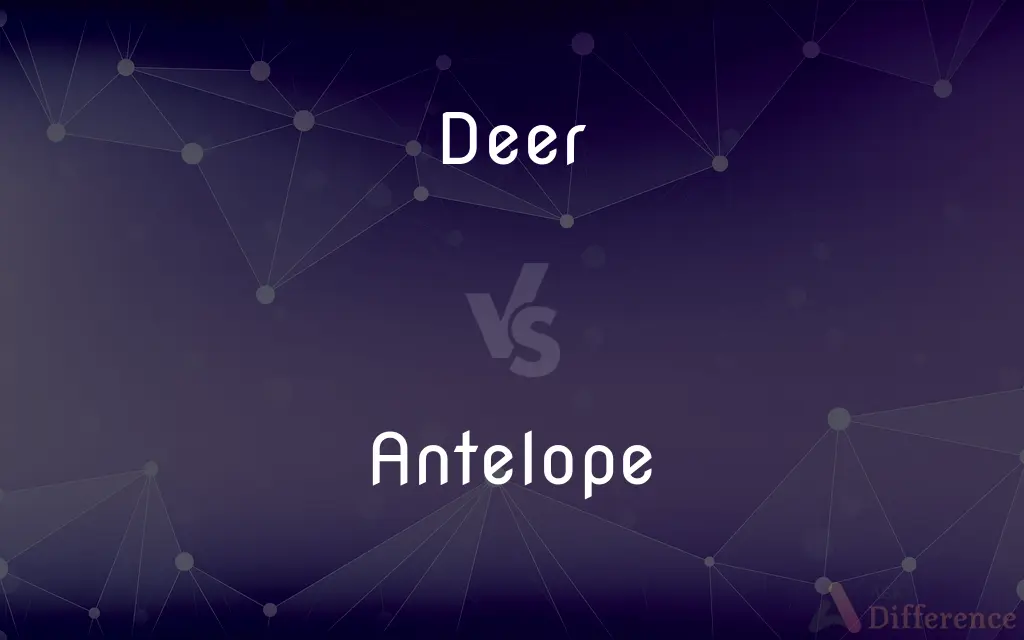Deer vs. Antelope — What's the Difference?
Edited by Tayyaba Rehman — By Fiza Rafique — Updated on November 1, 2023
Deer are forest-dwelling animals with branched antlers, while antelopes are typically African grassland dwellers with unbranched horns.

Difference Between Deer and Antelope
Table of Contents
ADVERTISEMENT
Key Differences
Deer are native to all continents except Australia and Antarctica, while antelopes are found primarily in Africa, with some species in Asia. Deer antlers are branched and shed yearly, contrasting antelope horns which are unbranched and permanent.
Antelopes are part of the Bovidae family, which also includes goats, cattle, and sheep. This differs from deer, which belong to the Cervidae family. While deer antlers are made of bone, antelope horns consist of a bony core with a keratinous cover.
The habitats of deer and antelope also vary. Deer tend to prefer wooded areas where they can forage for a variety of vegetation. Antelopes, on the other hand, are more likely to inhabit savannas and grasslands where they graze on grasses.
Deer species vary in size from the small pudu to the large moose, while antelope sizes range from the tiny royal antelope to the large eland. Both are herbivores, but their diets adapt to their respective environments.
Deer have played a significant role in mythology and culture, symbolizing gentleness and grace. Antelopes, especially in African cultures, are often symbols of vigilance and swiftness due to their alert nature and fast running speeds.
ADVERTISEMENT
Comparison Chart
Family
Cervidae
Bovidae
Horns/Antlers
Branched antlers, shed
Unbranched horns, permanent
Native Habitats
Forests, various climates
Grasslands, primarily in Africa
Cultural Symbolism
Grace, mythology
Vigilance, swiftness
Physical Characteristics
Vary greatly in size, coats
Often slender, adapted to running
Compare with Definitions
Deer
A hoofed grazing animal.
The deer roamed quietly through the forest.
Antelope
Possessor of permanent horns.
Sleek and pointed, the antelope's horns glistened in the sun.
Deer
Known for branched antlers.
A majestic stag displayed its impressive deer antlers.
Antelope
A symbol of alertness.
An antelope always seems aware of its surroundings.
Deer
Symbol of gentleness.
In stories, a deer often signifies purity.
Antelope
A graceful grassland animal.
The antelope dashed across the savanna.
Deer
Varied in size.
From the tiny deer to the towering moose, diversity is vast.
Antelope
Known for agility.
The antelope leapt over obstacles with ease.
Deer
A forest-dwelling creature.
The deer found shade beneath the tall oaks.
Antelope
Includes many species.
The savanna was home to several antelope species.
Deer
Deer or true deer are hoofed ruminant mammals forming the family Cervidae. The two main groups of deer are the Cervinae, including the muntjac, the elk (wapiti), the red deer, the fallow deer, and the chital; and the Capreolinae, including the reindeer (caribou), the roe deer, the mule deer, and the moose.
Antelope
The term antelope is used to refer to many species of even-toed ruminant that are indigenous to various regions in Africa and Eurasia. Antelope comprise a wastebasket taxon (miscellaneous group) within the family Bovidae, encompassing all Old World ruminants that are not bovines, sheep, goats, deer, or giraffes.
Deer
Any of various hoofed ruminant mammals of the family Cervidae, characteristically having deciduous antlers borne chiefly by the males. The deer family includes the white-tailed deer, elk, moose, and caribou.
Antelope
A swift-running deerlike ruminant with smooth hair and upward-pointing horns, of a group native to Africa and Asia that includes the gazelles, impala, gnus, and elands.
Deer
A ruminant mammal with antlers and hooves of the family Cervidae, or one of several similar animals from related families of the order Artiodactyla.
Antelope
Any of various swift-running ruminant mammals of the family Bovidae, native to Africa and Eurasia and having unbranched horns.
Deer
(in particular) One of the smaller animals of this family, distinguished from a moose or elk
I wrecked my car after a deer ran across the road.
Antelope
A pronghorn.
Deer
The meat of such an animal; venison.
Oh, I've never had deer before.
Antelope
Leather made from antelope hide.
Deer
Any animal, especially a quadrupedal mammal as opposed to a bird, fish, etc.
Antelope
Any of several African mammals of the family Bovidae distinguished by hollow horns, which, unlike deer, they do not shed.
Deer
Any animal; especially, a wild animal.
Mice and rats, and such small deer.
The camel, that great deer.
Antelope
(US) The pronghorn, Antilocapra americana.
Deer
A ruminant of the genus Cervus, of many species, and of related genera of the family Cervidæ. The males, and in some species the females, have solid antlers, often much branched, which are shed annually. Their flesh, for which they are hunted, is called venison.
Antelope
A fierce legendary creature said to live on the banks of the Euphrates, having long serrated horns and being hard to catch.
Deer
Distinguished from Bovidae by the male's having solid deciduous antlers
Antelope
One of a group of ruminant quadrupeds, intermediate between the deer and the goat. The horns are usually annulated, or ringed. There are many species in Africa and Asia.
The antelope and wolf both fierce and fell.
Antelope
Graceful Old World ruminant with long legs and horns directed upward and backward; includes gazelles; springboks; impalas; addax; gerenuks; blackbucks; dik-diks
Common Curiosities
What defines an antelope?
Antelopes are part of the Bovidae family, known for their unbranched horns and grassland habitat.
Do all deer have antlers?
Most male deer and some females have antlers, which they shed and regrow annually.
Can deer be found outside of forests?
Yes, deer can adapt to various habitats but prefer forested areas.
Are antelopes only native to Africa?
Primarily, yes, but some species are also found in Asia.
Why do deer shed their antlers?
Antlers are shed and regrown yearly as part of the deer's reproductive cycle.
Are antelope horns like deer antlers?
No, antelope horns are not shed and are unbranched, unlike deer's branched antlers.
Do all antelope have horns?
Yes, all antelope have horns, which are present in both sexes in most species.
What exactly is a deer?
A deer is a hoofed mammal, typically with branched antlers, from the Cervidae family.
How fast can an antelope run?
Some antelope species can run at speeds up to 60 mph (97 km/h).
How do deer and antelope differ in symbolism?
Deer symbolize grace and gentleness, while antelopes are symbols of vigilance and swiftness.
Are antelopes ever found in forests?
While less common, some antelope species do inhabit woodland areas.
What do deer eat?
Deer are herbivores, eating a diet of plants, leaves, and grasses.
Is it easy to differentiate between a deer and an antelope?
Yes, by looking at their horns/antlers, habitats, and body structure, one can differentiate between them.
What is the largest species of deer?
The moose is the largest species of deer.
What is the largest antelope?
The eland is the largest antelope.
Share Your Discovery

Previous Comparison
Piston vs. Plunger
Next Comparison
Quicksilver vs. MercuryAuthor Spotlight
Written by
Fiza RafiqueFiza Rafique is a skilled content writer at AskDifference.com, where she meticulously refines and enhances written pieces. Drawing from her vast editorial expertise, Fiza ensures clarity, accuracy, and precision in every article. Passionate about language, she continually seeks to elevate the quality of content for readers worldwide.
Edited by
Tayyaba RehmanTayyaba Rehman is a distinguished writer, currently serving as a primary contributor to askdifference.com. As a researcher in semantics and etymology, Tayyaba's passion for the complexity of languages and their distinctions has found a perfect home on the platform. Tayyaba delves into the intricacies of language, distinguishing between commonly confused words and phrases, thereby providing clarity for readers worldwide.














































